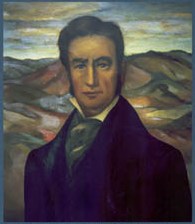William E. P. Hartnell: Diary and Copybook

The diary and copybook of outgoing letters kept by Englishman William E.P. Hartnell during his two years as Visitador General for the California missions (1839-1840) provides notable insight into a somewhat obscure, but very important part of California history.
Following the secularization of the Spanish/Mexican missions in 1833-34 they were administered by various priests and majordomos. The stated intent was still to turn the properties over to the mission Indians. Hartnell was commissioned by Governor Juan Bautista Alvarado to visit the various missions to see how this program was being conducted. His papers covering this time (held by the Bancroft Library) were in the form of a personal diary, a copybook of letters he sent out to various people during this time, a list of letters he receive with a précis of what they contained and a number of inventories of the property of a number of the missions.
These various documents have been arranged in chronological order to aid the reader and provide a better flow in reading the documents.
Educated in Germany, Hartnell went to South America as a young man and finally arrived in California in 1822 as a merchant. He met and married Teresa de la Guerra, daughter of the influential José de la Guerra y Noriega of Santa Barbara and they moved to the capital of the province of California, Monterey, where they raised a large family. Blessed with a gift for languages, Hartnell not only was fluent in German and Spanish, but also endeavored to learn Russian in his role as commercial agent of the Russian American Fur Company. His intellectual pursuits included starting an historical society and a school for young men, the first school in California.
Although much of Hartnell’s writing is for official purposes, he shows real concern for the welfare of the Indian people who should have been benefiting from dispersal of the mission property and lands. However, the tragedy that was unfolding at the time wherein the property was mostly turned over to non-Indians becomes clear in his entries and finally leads him to resign his post when he realized that even the governor was involved in this betrayal of Indian interests. Hartnell comes off as a man of high integrity in his attempt to carry out his mission, but unfortunately, he was running against the tide of history.
The original Spanish was translated by the late Starr Gurcke and then edited and annotated by Glenn Farris. A particular value to this book is the lengthy list of individuals and places named in his accounts. It took a number of years to track down information on almost all of the people and places mentioned. The book thus is a valuable resource to historians and genealogists, especially in that it fills in a much overlooked period of transition in early California history.
Synopsis by Glenn Farris, Retired Senior State Archaeologist, California State Parks
Book Reference Information:
Gurcke, Starr Pait, translation, and Glenn J. Farris, editor, THE DIARY AND COPYBOOK OF WILLIAM E. P. HARTNELL.
To Contact the Publisher go the California Mission Studies Association website at http://www.ca-missions.org
